Generate the NC Code
You can generate the NC Code interactively.
Right-click a Manufacturing Program in the Activities Process Tree and select
Generate NC Code
Interactively  . .
You can also launch the command from the West Compass toolbar.
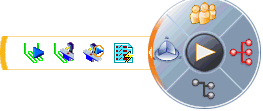
The Generate NC Output Interactively dialog box is displayed.
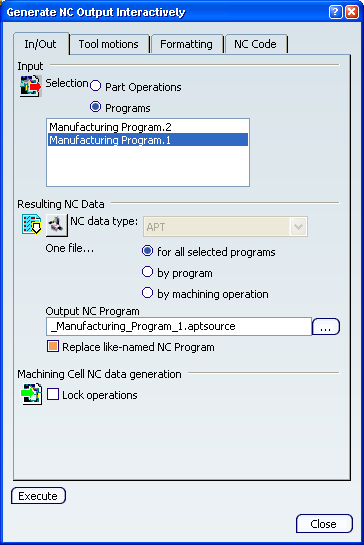
Define the Input:
Define the resulting NC Data:
- NC data type: this type is defined globally in the machine associated to the Manufacturing Program. However, you can modify it locally. Click
 and select the required NC data type from the list. See
Working with Generic Machine Editor. and select the required NC data type from the list. See
Working with Generic Machine Editor.
- Select the desired One file...
option.
- Under Output NC Program, specify the name of the NC Program file.
- Click ... to select an existing NC Files Container from a list of NC Files Containers attached to the Machining Cell.
- Select the Replace like-named
file NC Program check box, to authorize overwriting an existing
like-named NC Program.
- Select the Lock operations
check box to lock all the Machining Operations after
processing. See About Lock/Unlock Mechanisms
Go to Tools Motions and Formatting
if you need to modify locally the machine parameters.
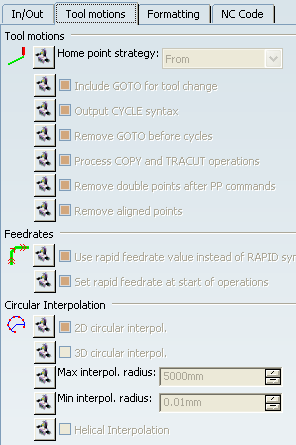
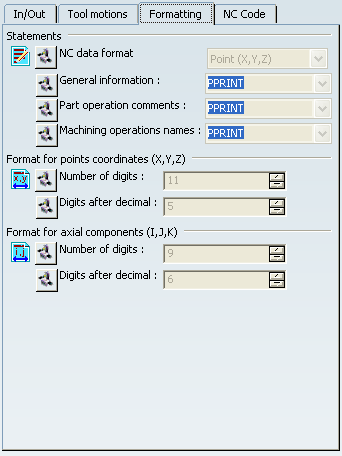
See Working with Generic Machine Editor.
When required, go to NC Code to specify a post-processor.

- If not already done, go to to select the type of Post Processor (Cenit, Intelligent Manufacturing Software (IMS), and ICAM Technologies Corporation).
- If the output option is set to None, you cannot generate the NC code.
- The content of the NC Code tab varies according to the post-processor selected.
Click Execute to generate
the NC Code file.
The NC Code Generation progress bar is displayed with the Machining Operations being processed for output and the percentage of progress. The errors and warnings are also displayed in the NC Output Errors and Warnings dialog box.
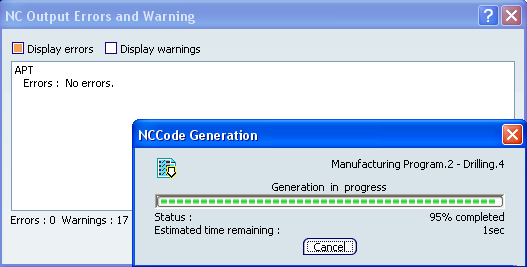
- Go to and select No. of Errors and warnings checkbox.
This helps to configure the output generation stopped after the number of errors and warnings crossed a certain value.
- Click Cancel in the NC Code Generation progress bar to stop the output generation.
- Click OK in the message that is displayed.
This message indicates whether the output generation was
successful or not. If there are errors or warnings while generating
the NC output, the message indicates the number of
errors/warnings.
- Select Display errors and Display warnings check box in NC Output Errors and Warnings dialog box to view errors and warnings generated during output generation.
- Select error or warning in NC Output Errors and Warnings dialog box to highlight the Machining Operationin Activities Process Tree.
This helps to edit the Machining Operation and perform correction, as required.
- Click Close to exit the NC Output Errors and Warnings dialog box.
- A NC Files Container named
_Manufacturing_Program_x is created under the Machining Cell.

Note:
The NC Files Container containing the created Output NC program can be stored in the database as a PLM Object.
- It contains the NC Code file and a log file. See Generating NC Code
Note:
The log file contains machining
time information similar to that obtained during the
interactive Tool Path Replay, as well as warning/error
message entries. If the Activate Collision Checking check
box is selected in the Part Operation dialog box (see Creating a Part Operation),the log file indicates whether
any collisions have been detected.

View the NC Programs
You can view the generated NC code files.
To view the NC Code files, either:
- Right-click the
NC Files Container named
_Manufacturing_Program_x under the Machining Cell and select View NC Program in the contextual menu.

- or right-click the Manufacturing Program and select Display NC program.

The Select File to View dialog box appears and lists all files inside the NC Files Container linked to the Manufacturing Program.
Select the required file in the dialog box and click View File. The dialog box remains open to select and view more files.
|